Last Updated on August 17, 2023 by Aaron von Frank
Find out how to eat a fresh pawpaw or process pawpaw fruit for long-term storage in your freezer.
Table of contents:
I. Quick introduction to pawpaws (Asimina triloba)
II. Warnings about eating pawpaw fruit
III. Pawpaw harvesting and storage tips
IV. How to eat fresh pawpaws
V. How to process pawpaw fruit for freezer storage
VI. Pawpaw recipes
I. Quick introduction to pawpaws (Asimina triloba)
Are you a first-timer who’s been lucky enough to get your hands on pawpaw fruit (Asimina triloba), North America’s largest — and arguably tastiest — native fruit? Are you now wondering how to eat this strange new fruit?

Pawpaw: from flower to ripe fruit. In our area, pawpaw flowers emerge in early March. The ripe fruit is ready to harvest for 2-3 weeks, from late August through mid-September, with some variability by year.
Bite into it like an apple? Peel it?
Or are you a forager or orchard gardener with a huge haul of pawpaw fruit? Now you’re trying to figure out how to efficiently get all that delicious pawpaw fruit separated from the skin and seeds so you can store pawpaw in your freezer for later use (aka “process pawpaw fruit”).
Either way, you’ll find the answers to your pawpaw processing questions in this article!
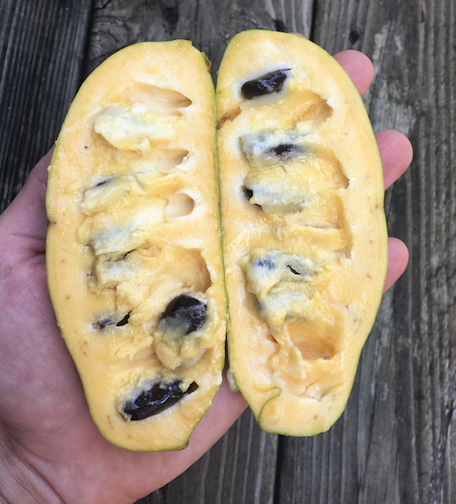
Pawpaw perfection! A ripe homegrown pawpaw cut in half showing the orange/yellow pulp and the large black seeds inside.
Pawpaws are a perennial fruit tree that made the cut for our top-5 fruit & nut trees to grow for our Ag zone, 7b. That top-5 list is based on three primary criteria: quality of the fruit/nut produced (nutrition + flavor), low maintenance, and yield.
We also have a detailed article all about how to grow pawpaw trees organically (from seed or sapling), if you’d like to grow your own pawpaws.
We currently have four fruit-producing pawpaw trees and ten more young plants that should start producing fruit in the near future. We also have pawpaw foraging spots where we can gather dozens of pounds of pawpaw fruit in a short 2-3 mile hike. Lucky us!

A large quantity of foraged and home-grown pawpaw fruit.
Thus, during pawpaw season we end up with more fruit than we could possibly eat fresh, so we have to process and store it in our freezer for later use. Below, we’ll share our pawpaw harvesting and processing tips to help you do the same.
But first some important pawpaw warnings…
II: Warnings about eating pawpaw fruit
Before you sink your teeth in, let’s start with a warning: eating pawpaws can make some people sick. And depending on how pawpaw fruit is prepared, it can make someone sick who might otherwise easily tolerate raw pawpaw.
Pawpaw consumption safety parameters:
Lowest risk: raw pawpaw fruit
A small percentage of people will experience GI distress from eating fresh/raw pawpaw fruit. This is not unusual — for every food on earth, you can find someone who has aversions or allergies.
Also note that some people may experience contact allergies (rashes, itchy skin, etc) from pawpaw fruit skins, leaves, and bark.
Medium risk: cooked pawpaw
Eating cooked/baked pawpaw fruit increases the risk of GI distress. We’ve also found that cooked pawpaw fruit can develop off flavors – sickeningly sweet while oddly bitter.
High risk: dehydrated/dried pawpaw
Eating dehydrated pawpaw fruit increases the risk of GI distress to such a heightened degree that you should NOT make or consume dehydrated pawpaw fruit. If you need more convincing, read the warnings and graphic personal accounts of people who ate dried pawpaw fruit via a newsletter from The Ohio Chapter of the North American Pawpaw Growers Association.
Here’s how these warnings translate into safely eating pawpaws:
1. If you or someone else has NEVER eaten pawpaw before, only try a small amount of the fresh/raw fruit your first time. If you have no adverse reaction after 12 hours or so, you can assume you’re able to eat the raw fruit.
2. When consuming baked/cooked pawpaw for the first time, only try a small amount. If you have no adverse reaction after 12 hours or so, you can assume you’re able to eat the baked/cooked fruit, at least in moderation.
Personal note: We’ve had family members who ate lots of raw pawpaw one day with no problem. The next day, eating baked pawpaw led to an unpleasant bathroom experience.
3. Don’t ever eat dehydrated pawpaw fruit, even if you’ve never experienced an adverse reaction to the raw or cooked fruit. If you’re absolutely determined to break this rule, then you might want to only eat a very small amount when you do.
Are there any long-term health risks of eating pawpaw?
Maybe, but there’s not much research out there on this topic. Here’s what’s known:
Annonacin is a chemical compound found in all Annonaceae fruits, from tropical soursops and custard apples to our subtropical pawpaws. Interestingly, annonacin has potential cancer-fighting medical benefits. However, it’s also known to be a potent neurotoxin that’s been shown to cause increased rates of neurodegenerative diseases (like Parkinson’s and Alzheimer’s diseases) in lab rats and in human populations who regularly consume it.
We’re aware of all these warnings, but still eat pawpaws – albeit carefully. For us, pawpaws are a seasonal fruit, not something we eat daily or in high quantities. We also take *lion’s mane mushroom supplements every day of the year, which promotes neurogenesis while protecting against neurodegenerative diseases. Hopefully, that practice balances the equation!
(*We use lion’s mane capsules from Host Defense, Paul Stamet’s company.)
III. Pawpaw harvesting and storage tips
Now for some helpful pawpaw harvesting and storage tips:
1. Picking or harvesting pawpaws
The best, most flavorful pawpaws are the ones that are slightly soft and have just fallen off the tree. When ripe, they should also have a delicious, tropical-fruity smell evident when the skin is still on.
Don’t pull unripe pawpaws off of the tree – and don’t eat unripe pawpaw fruit (unripe pawpaw fruit can also make you sick). If you give the tree a good shake and the fruit does not fall off on its own, it’s most likely hard, unripe, and not yet ready for harvest.
If you happen to find a pawpaw fruit that’s still barely clinging to the stem on the tree, it’s ok to pick those as well, but if it doesn’t yield with a tree shaking, leave that fruit on the tree to ripen further.
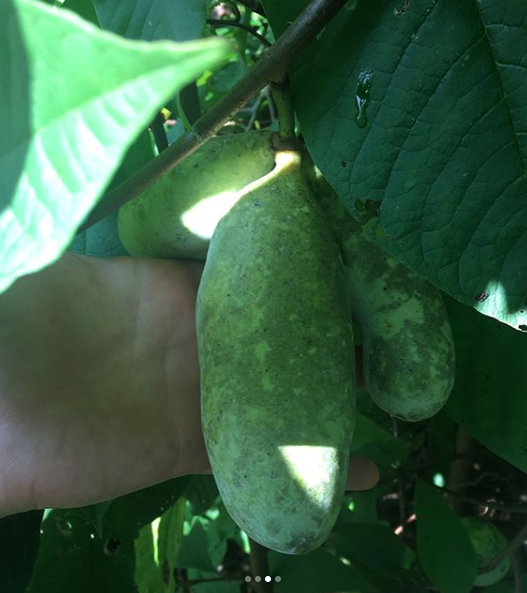
An almost ripe cluster of pawpaws. For optimal flavor, leave the pawpaws on the tree until they’re ripe enough to fall off on their own or be shaken off.
Two other common questions we hear:
a. Can unripe pawpaw fruit ripen off the tree?
It depends. If pawpaw fruit is fairly close to being ripe on its own, you can pick it hard and let it ripen over a few days on your counter at room temperature. This comes in handy if you’re far from home at a foraging spot that you won’t be able to return to by the time the fruit is fully ripe.
However, you can pick pawpaw fruit that’s too immature to fully ripen off the tree — or ripen to a flavor that tastes as good as it would if it had ripened on the tree. Again, eating unripe pawpaw fruit is likely to make you sick, so it’s best to only eat perfectly ripened pawpaws.
b. Do pawpaw skins turn yellow/orange when ripe or do they stay green?
There is a tremendous amount of genetic diversity in both wild and cultivated pawpaws. This diversity leads to different colors and flavors in the fruit, from tree to tree.
For instance, one of the pawpaw trees in our small forest garden produces fruit whose skin turns from green to yellow when ripe. However, we also grow and forage from pawpaw trees whose fruit stays fully green when ripe.
2. Storing pawpaw fruit
The primary reasons pawpaws have NOT been commercially successful/popular is because:
- They don’t seem to ripen to ideal flavor if picked when hard and unripe; and
- They’re typically quite thin-skinned, causing them to damage easily and have a very short shelf life.
Pawpaw’s absence from modern grocery store shelves has nothing to do with their flavor, because they are out-of-this-world delicious.
What does pawpaw fruit (Asimina triloba) taste like?
Pawpaws taste like a creamy combination of mangos, bananas, and persimmons. They’re like something you’d expect to find at a tropical fruit market in Costa Rica, not a forest trail in the Appalachian Mountains.

A perfect pawpaw fruit, just fallen from the tree. A ripe pawpaw is slightly soft to the touch and smells delicious. Note: this is a bred variety from one of our trees and is fairly large. In the wild, they can be as small as golf balls, and fruit size — even on the same tree — can vary significantly.
How long does pawpaw fruit last?
Once a ripe pawpaw is off the tree, it will last:
- about 2 days stored at room temperature,
- 5-7 days stored in the produce drawer of your fridge.
Do your best NOT to pile ripe pawpaw fruits on top of each other or put anything else on top of them. Doing so will cause the fruit to bruise and turn bad faster.
Keep this in mind when foraging the fruit as well – a ripe pawpaw can turn to mush if stacked deeply in a backpack during a hike. Yes, we know this from experience!
IV: How to eat fresh pawpaws
When gardening or foraging, we sometimes have what we refer to as a “good problem.” A huge haul of food that we can’t possibly eat before it goes bad.
For instance, we recently came back from a hike with 25 pounds of pawpaws from a prime foraging spot. With pawpaw trees at home to add to the haul, we have to process much of the fruit for later use because there’s no way we can eat it all fresh.
Plus, we generally avoid eating large quantities of pawpaws at once for reasons cited above.
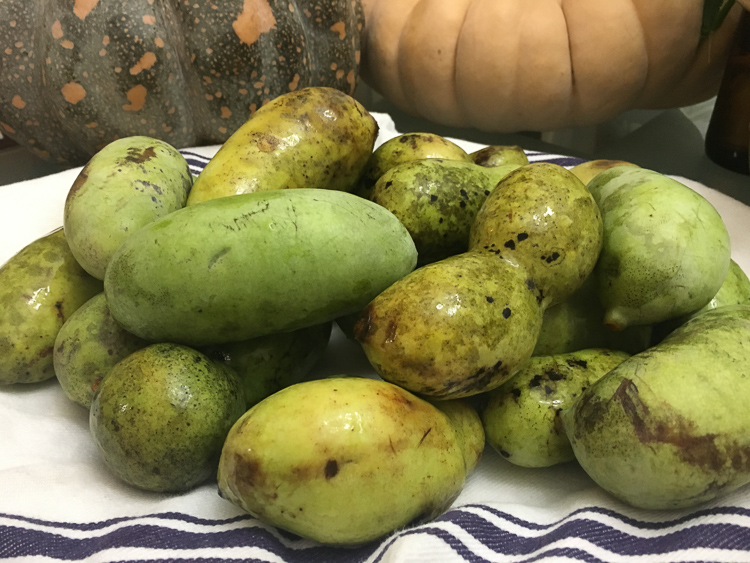
A nightly harvest of pawpaws from our own trees adds to the wild-foraged bounty. A wasted pawpaw is a travesty punishable by flogging and shunning in our family, so knowing how to process them to freeze for later use is essential if you have a lot of fruit.
1. First thing: how to eat fresh pawpaw fruit
If you’re new to the world of pawpaws, here’s a quick primer on how to eat them…
Step 1: Wash the fruit surface gently but thoroughly.
Your pawpaw fruit has likely been on the ground. To avoid the possibility of ingesting an unwanted dose of pathogenic microbes left behind by another critter, give each pawpaw fruit a gentle but thorough washing with warm soapy water. (We eat lots of strange things and have the microbiomes of feral goats, so we have been known to violate this rule when foraging.)
A soft sponge works great for cleaning pawpaws. Again, be gentle and try not to tear the pawpaws’ skin, because that will make it go bad faster and more difficult to store.
Step 2: Cut the fruit in half, longways.
Using a knife, make an incision all the way around the fruit longways.
Your knife will almost certainly encounter the large hard seeds inside, so don’t try to cut through the seeds. Just work around them and keep going. Once your knife is back to the starting point, twist the pawpaw with both hands, pulling it apart into two even halves.
Step 3: Spoon out the fruit, spit out the seeds.
Hold half of a pawpaw fruit in your hand at a time. Using a small spoon, scoop out and eat spoonfuls of the delicious soft pulp. The texture of ripe pawpaws is surprisingly creamy and smooth.
Pawpaw fruits’ thin skin is often bitter and shouldn’t be eaten. Just scrape out the fruit pulp and compost the skin. The large hard seeds of pawpaws are also inedible and should not be eaten.
Don’t discard the seeds! Sow them in an ideal wild habitat or in nursery pots at home. In ~5 years, you’ll have a new fruit-producing pawpaw tree!

This is what a pawpaw seed looks like with pulp removed. The pawpaw saplings (background) in the pots are two year old pawpaw trees grown from seed. Plop your seeds about an inch deep in potting soil, let them overwinter outside (they need cold-stratification), and they’ll germinate in the spring. For the first three years, keep them out of full sun, since the young plants actually prefer part shade. Plant 3-year-old saplings in a full-sun spot and around year 5 you should start getting fruit.
To save space and potting soil, we typically start multiple pawpaw seeds in the same pots. Then when they go dormant at the end of their first year, we carefully separate them out into their own pots.
V: How to process pawpaw fruit for freezer storage
When you have larger quantities of pawpaw fruit that you need to process and freeze, here’s how to do it:
Step 1: Wash then cut the pawpaw fruit in half as per the instructions in the previous section.
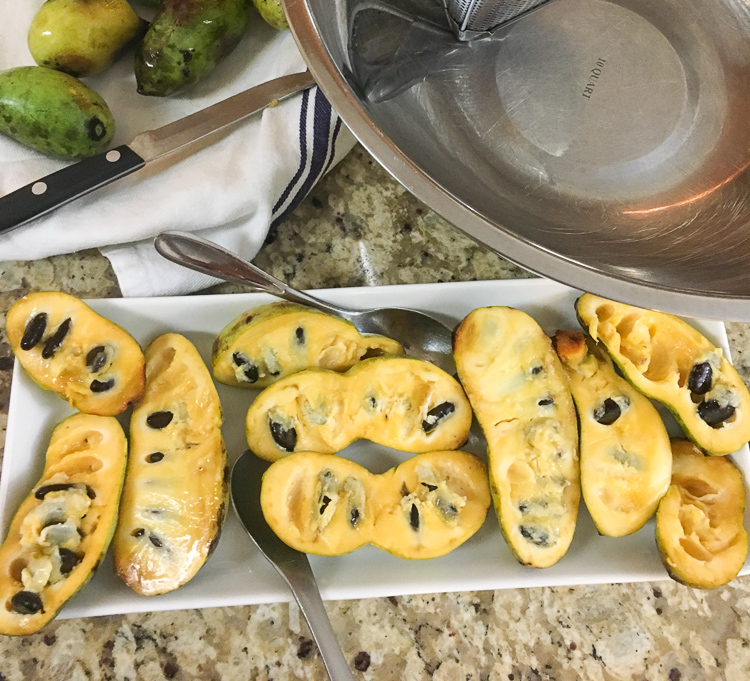
How to process pawpaw fruit: getting started. Have knives, spoons, and a large bowl at the ready.
Step 2: (For SMALLER batches – under 5 pounds) Scrape the pulp away from the seed with a knife.
If you only have 5 pounds of fruit or so, you might want to take the time to get every bit of pawpaw pulp you can fruit your fruit, including the pulp attached to the seeds.
The fruit pulp around the seeds will scrape right away with a knife. Put each half of pawpaw on a plate and scrape away at each exposed seed.

These pawpaw seeds were covered with pulp, but they’ve now been scraped with a knife and ready to be pulled out.
Pretty soon, you’ll have half of a pawpaw with no seeds inside.
ALTERNATE: (For LARGER batches, 5+ pounds) Scoop out pulp AND seeds and strain through chinois strainer.
When we have large batches of pawpaws to process and we’re not worried about getting every scrap of pulp from around the seeds, we use a chinois strainer.
Simply scoop the pawpaw pulp and seeds into the strainer, then toss the skins into the compost. We use both the pestle that comes with the strainer plus a silicone spatula to push as much pulp through the small openings as possible.

Processing pawpaw fruit (Asimina triloba) through a chinois strainer. The seeds on the right show how much pulp you can expect to lose by using a chinois strainer vs the slower but more thorough method of removing seeds by hand.
With a chinois strainer, we can process about 10 pounds of pawpaw fruit in 30 minutes, but some pulp is left on the seeds as you can see in the photo above. Also note that a chinois strainer will tun pawpaw pulp into a much finer texture but not as smooth as a food processor or blender, so you’ll probably want to puree the pulp in one of those tools before freezing.
In case you’re wondering, for every 1 pound of pawpaw fruit, you can expect to get about 1/2 cup of processed pulp. (*This ratio may not apply to certain bred varieties with smaller and fewer seeds.)
Step 3. Remove the fruit, leave the skin.
Now back to the small batch processing steps… Using a spoon, scrape out all the pulp.

Yummy pawpaw fruit, seeds removed. Ready to be scooped out by spoon.
The only thing that should be left after you’re done with the spoon is a thin layer of skin.

It’s kind of hard to tell from this photo, but there’s only a thin layer of skin left here. Remember, the skin is bitter and inedible so you only want to scrape out the fruit, leaving the skin behind.
Step 4. Purée until smooth.
Once you’ve gone through the above steps with each of your pawpaws (assuming you’re not using a chinois strainer), you should have a large bowl of chunky pawpaw pulp. Sure, you can put this in the freezer as-is, but if you want to use your frozen pawpaw for recipes like our pawpaw passionfruit sorbet or no-bake pawpaw cheesecake, then large chunks of pawpaw fruit aren’t going to work.
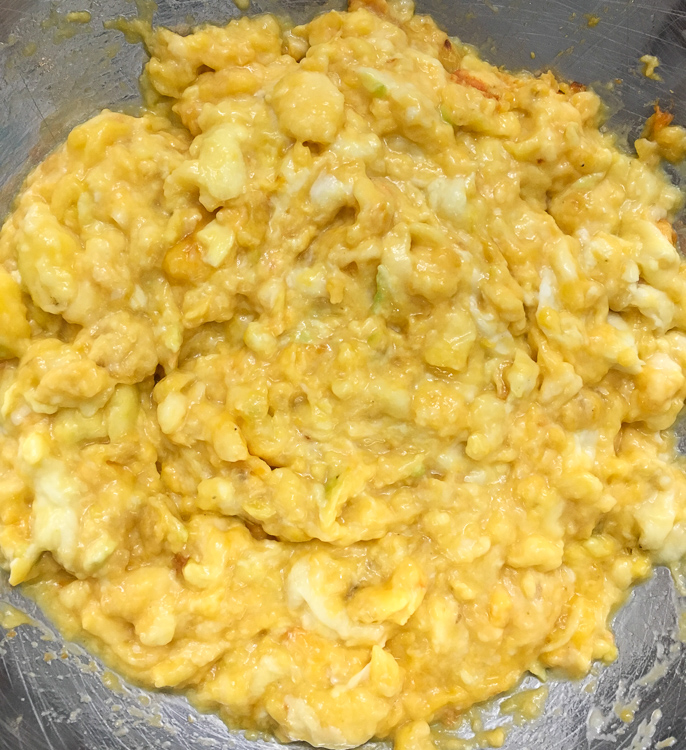
Chunks of pawpaw fruit pulp, separated from the seeds and skin.
This is where we use one of our absolute favorite kitchen tools: our Bamix immersion blender. It’s so much easier to use and clean than a food processor when you’re making soups, shakes, puddings, sauces, etc.
Alternately, you can use a standard food processor or blender.
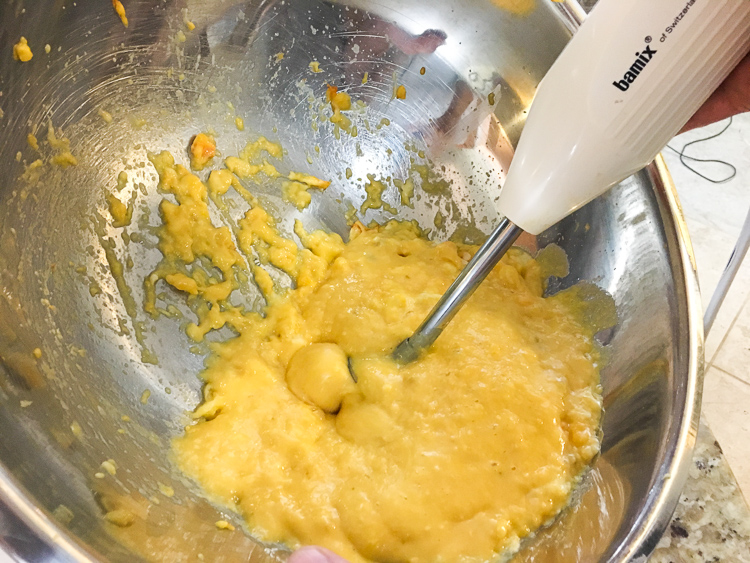
Our Bamix immersion blender turning chunks of pawpaw pulp into smooth, creamy deliciousness.
Purée your pawpaw fruit until its silky smooth.
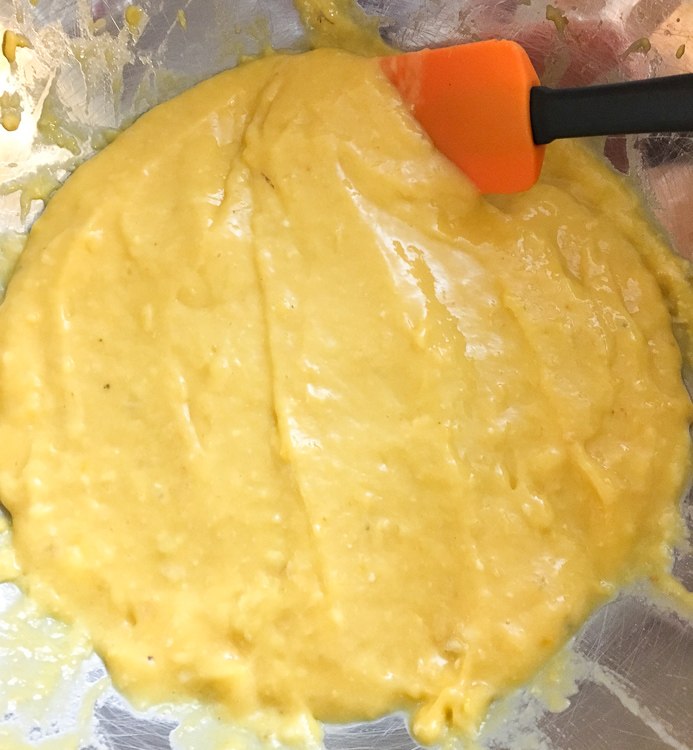
Processed pawpaw fruit ready to go into freezer bags.
Step 5. Scoop into labeled freezer bags and freeze.
Almost done! Want to make “future you” happy? Measure out how much pawpaw purée you’re scooping into each ziplock freezer bag (or silicone bag), then using a sharpie pen, write the following information on to your freezer bag for future you:
- “pawpaw puree”
- quantity (fill in the blank)
- date processed (fill in the blank)

Old picture but the point still stands… 1/2 cup and 1 cup freezer bags of pawpaw, processed and ready for “future us.” Future us will be very happy.
When future you goes looking for pawpaw purée for a recipe, they’ll be very happy with how well you planned ahead!
VI. Pawpaw fruit recipes
We don’t eat cooked pawpaws, only raw. If you’re looking for raw pawpaw recipe ideas, here are two we love:
1. No-bake pawpaw cheesecake with toasted nut crust. You’ll need a lot of pawpaws, but this recipe is out-of-this-world delicious!

2. Pawpaw-passionfruit sorbet. With the addition of native passion fruit (Passiflora incarnata), you can combine two native fruits into one delicious recipe. The tanginess of passion fruit pairs perfectly with the creamy sweetness of pawpaws.

We’ll be adding more pawpaw recipes as we create them. In the meantime, rest assured that pawpaws are so delicious eaten fresh/raw, that you can eat them as-is or blend them into unforgettable drinks and smoothies. That’s to say, they don’t require anything fancy to be delicious.
Now you know how to eat and process pawpaw fruit. We hope you enjoy this delicious native fruit as much as we do!
If you want to order pawpaw trees for your garden, here’s a good source. Note that pawpaws are NOT self-fertile. So you’ll want to order at least two pawpaw trees and plant them relatively close together (no more than 20 yards apart) to get good fruit production.
Other Tyrant Farms’ pawpaw articles you’ll enjoy:
- How to grow pawpaw trees organically
- Recipe: pawpaw passionfruit sorbet recipe
- Recipe: No-bake pawpaw cheesecake with toasted nut crust
KIGI,

Like what you're seeing here? Please be sure to subscribe to Tyrant Farms so we can let you know about new articles you'll love.



18 Comments
Joe psotka
October 21, 2023 at 8:26 amAccording to Andrew Moore, lewis and Clark’s expedition had DRIED PAWPAWs and loved them.; so too the Iroquois. Apparently they dried them with lye or ash. So, there may be a way to remove the poisons from dried fruit. Any ideas?
Aaron von Frank
October 21, 2023 at 9:40 amPerhaps lye and/or hardwood ash would bind whatever toxins in oxidized pawpaw fruit causes GI distress. Personally, it’s just not worth it to us to find out since we’re perfectly happy just eating small amounts of the fresh, raw fruit when it’s in season (and fresh frozen fruit sporadically throughout the year). In addition to pawpaw fruit’s acute toxicity issues, we’re also not too keen on eating large quantities of something that can cause long-term neurodegenerative disease. Another concerning anecdote from this year: we have family a few hours away who made a slushy with their fresh, ripe home-grown pawpaws. Thinking them delicious (which they are), each of the three people who drank the slushy consumed about 1.5 cups of fresh pawpaw pulp. They all spent half of the next day on the toilet. Thankfully, there were three toilets available in their house.
Amy Salva
September 4, 2023 at 6:41 pmHoping to distill some paw paw fruit from our backyard. Any thoughts? We have done pear and apple with success. I’m assuming we should only use ripe fruit?
Aaron von Frank
September 5, 2023 at 5:32 pmIf you’re going to make spirits with pawpaw fruit, we’d definitely recommend only using ripe fruit. There’s actually no circumstance under which we’d recommend consuming unripe or under-ripe pawpaw fruit either. For reasons we detail in the article, pawpaw is a fruit we now only eat raw and in moderation. We’d be hesitant to cook or distill it due to the potential for GI distress – if not our own, for other people who may be sensitive. We did have some friends who made a really good pawpaw beer one time.
Chip
October 15, 2022 at 10:10 amI have two different paw-paw trees planted, both provide more than enough fruits every year. I need to know how to prepare unripe paw=paws for eating, if doable.
Aaron von Frank
October 17, 2022 at 10:29 amThe flavor and texture of unripe pawpaws render them inedible. If you harvest them within 2-3 days of when they’d naturally ripen on the tree you can pick them early and let them ripen on the counter. However, if you pick unripe pawpaws any earlier than that time window, they will not ripen off the tree no matter how long you let them sit. We’ve come to that conclusion based on experimentation with lots of different pawpaw fruit across lots of different trees.
Bill & Debbie Malone
September 18, 2022 at 3:04 pmJust a note, we live in Southern Indiana & have tons of Paw Paw trees in our woods. Just picked up about 60 fruits. The woods smell so wonderful as the fruit bears a lovely fragrance.
Gerry Jaworski
August 3, 2022 at 11:05 amA bird dropped seeds apparently. I’m in NW Ohio and this gorgeous looking southern tree brings in at least 50 paw paw fruit. Second year they’ve grown.
Aaron von Frank
August 3, 2022 at 11:34 amLucky you! Given the size of pawpaw seeds, it was most likely a mammal (such as a raccoon, possum, or skunk) who brought pawpaw seeds to your yard via their scat. Birds might peck at pawpaw fruit, but they wouldn’t be able to eat the seeds.
jakohar97
July 15, 2022 at 3:01 pmVery interesting article, I love these things. I enjoy them fresh and have also had jams made from them -delicious! However, when I tried to freeze them they tasted pretty bad. Any ideas why?
Aaron von Frank
July 16, 2022 at 7:36 amNo matter what you do, frozen fruit (including pawpaw fruit) usually doesn’t taste as good as fresh because of the cellular damage that happens during freezing. This effect is made much worse if there’s freezer burn and/or if the fruit is frozen for multiple years prior to consumption. Here are a few things that will help ensure the best possible flavor of frozen pawpaw and other fruit:
1) Use freezer bags instead of standard ziplocks bags. (Or use silicone bags if you want a plastic alternative.)
2) Vacuum seal your bags before putting them in your freezer. You can buy devices for this, but I just do it by sealing all but the far corner of a ziplock then sucking the air out with my mouth before quickly sealing the remaining section shut.
3) Eat your frozen fruit within months or no more than a year.
Hope this helps!
jakohar97
July 19, 2022 at 11:34 pmThank you for the advice!
Elaine
September 26, 2021 at 1:07 pmWill paw paw trees grow in California (Northern)?
Aaron von Frank
September 27, 2021 at 12:30 pmHi Elaine! Pawpaws should do ok in northern California since you have higher humidity, but probably not in southern California where it’s hotter and dryer. What I don’t know about your area is how many winter chill hours you average. Pawpaws generally require a minimum of 400 chill hours/sub-freezing winter temps while they’re dormant in order to produce fruit. There is a lot of pawpaw breeding work going on around the country, so perhaps you could search for: a) pawpaws bred for west coast conditions, and b) pawpaws with lower chill hour requirements. That way, you can be sure to get a cultivar(s) ideally suited to your location. Hope this helps!
Erik
May 21, 2025 at 5:48 pmI plan on freeze-drying pawpaws this year using no heat.
Am i wrong to assume it is the heat that activates the irritation people experience? Freeze drying preserves much more of the freshness that food dehydrating cuts out.
Anyway, i plan on testing my hypothesis this fall.
Susan von Frank
May 22, 2025 at 10:54 amEric, It’s hard to say for certain. It sounds to me like it’s actually an oxidative process that’s causing additional problems with pawpaw fruit. Maybe try a small batch of freeze dried pawpaw to see if you or anyone else planning to eat it is going to have sensitivities or negative reactions before you freeze-dry a big batch. Please check back in if you do.
Brandie Gruenewald
September 23, 2021 at 7:58 pmThis article is so helpful. I came across pawpaw last year on a hike by my house. I was like what the heck is this then did my research. By that time, they were all brown and on the ground being eaten by the forest floor. So I marked my calendar for Sept 2021 and here we are! I foraged about 10 from the same park and am using your guide to prepare them as we speak! Thank you so much for the information and inspiration!
Aaron von Frank
September 24, 2021 at 12:41 pmOoh, lucky you! Nice to have a wild pawpaw patch near your house. Glad this article was helpful and hope you get to enjoy some pawpaw fruit this year. It’s absolutely delicious. Do keep in mind that there can be some variability between pawpaw ripening time from year to year depending on the weather (example: ours was 3-4 weeks later this year than last year). Can’t hurt to check your spot(s) a little early each year to see how they’re coming along and make sure you don’t miss them. Give those pawpaw trees a good shake and cover your head!